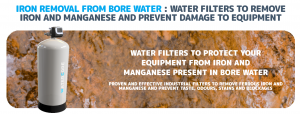Iron Removal from Bore Water: Chemical-free Vs Chlorine Oxidation before Filtration
Australian bore water can contain high levels of soluble iron. Depending on the PH, aeration can be enough to oxidase and precipitate iron before filtration
Watercore Launches a New Range of Chemical Dosing Systems for Water Treatment Applications announced 4 days
About Watercore
|Share
Iron Removal from Bore Water: Aeration VS Chemical Oxidation before Filtration
Depending on the iron concentration and the PH found in bore water, it may be possible to use only aeration to oxidase and precipitate the iron before filtration
Iron removal is a common treatment for commercial industrial and drinking applications. Iron and Manganese in their oxidized forms can contribute to suspended solids in water. Found as dissolved ions in many underground water sources, Iron and Manganese become insoluble solids after oxidation when in contact with Oxygen present in surface waters.
Australian bore groundwater can contain soluble Iron and oxidised Iron as hydroxides and oxides. Bore water often contains high levels of soluble iron which is oxidised and forms particles when in contact with the dissolved oxygen in water.
Iron concentrations in bore water typically range from 0-10.0 mg/L, but 20 mg/L or higher are not uncommon. Manganese is much less common, and typically ranges from 0-2.0 mg/L.
In general terms and when present in low to medium concentration levels in drinking water, Iron does not represent a risk to health or the environment. However, it brings an unpleasant metallic taste and colour to the water flow.
In commercial and industrial environments Iron has a much bigger impact: Iron will deposit on surfaces and cause corrosion, overheating problems, clogs and blockages. Iron deposits on the heat transfer surfaces are typically hard, dense and porous and accelerate corrosion while generate an insulating effect that prevents heat transfer and causes the temperature of metals to increase.
Iron removal from bore water involves converting it into non-dissolved particles that can be removed by standard filtration methods. Treated water can have an Iron content as little as 0.01 ppm, which qualifies for membrane filtration systems such as reverse osmosis, nanofiltration or ultrafiltration.
Dissolved Iron cannot be filtered easily so the common practice consists of transforming it into the undissolved form and then remove the particle flocks by filtration.
Hence, removal of Iron from water is divided in two separate stages:
Oxidation and precipitation of dissolved ferrous Iron into particulate Ferric Iron (hydroxide).
Removal of precipitated Iron particles by means of media filtration
The oxidation stage can also be carried out by:
Aeration in cascades or spraying open-air systems similar to cooling towers
Chemical dosing of stronger oxidants such as Chlorine or Potassium Permanganate
Aeration requires a significant footprint but is easy with low running costs other than the initial investment. It also helps removing aggressive CO2 and with Hydrogen Sulfide removal.
Oxidation by means of chemical dosing is faster than aeration and very effective regardless of the iron content in water, however operational costs will be higher and chemical handling will be a part of the process.
Depending on the iron concentration the PH founf in water, it may be possible to use only aeration to oxidase and precipitate the iron before filtration.
Both iron and manganese can always be oxidised with aeration, however the kinetics of this reaction depend heavily on the pH. Below a pH of 7, oxidation by aeration is very slow and requires a long contact time (more than 30 min). Although this process is chemically possible, it is not economically viable.
Iron oxidation occurs best within a pH range of 7.5-8, where aeration can take place in around 10 min.
At Watercore, our team of bore water Iron filtration experts can point you in the right direction in regards to the best possible option for your iron removal.
David Garcia
Watercore
+61 1300 742 010
email us here
Visit us on social media:
Facebook
Twitter
LinkedIn
Legal Disclaimer:
EIN Presswire provides this news content "as is" without warranty of any kind. We do not accept any responsibility or liability for the accuracy, content, images, videos, licenses, completeness, legality, or reliability of the information contained in this article. If you have any complaints or copyright issues related to this article, kindly contact the author above.


